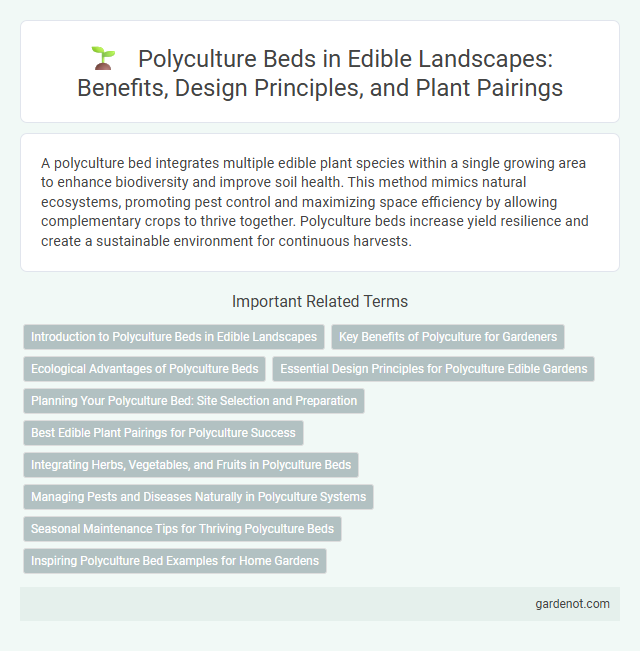A polyculture bed integrates multiple edible plant species within a single growing area to enhance biodiversity and improve soil health. This method mimics natural ecosystems, promoting pest control and maximizing space efficiency by allowing complementary crops to thrive together. Polyculture beds increase yield resilience and create a sustainable environment for continuous harvests.
Introduction to Polyculture Beds in Edible Landscapes
Polyculture beds in edible landscapes integrate multiple plant species to enhance biodiversity, soil health, and pest resistance. This sustainable gardening technique mimics natural ecosystems by combining complementary crops, such as nitrogen-fixing legumes, nutrient miners, and pest-repellent herbs. The diverse planting structure in polyculture beds promotes higher yields and resilient food systems while reducing the need for synthetic inputs.
Key Benefits of Polyculture for Gardeners
Polyculture beds enhance garden biodiversity by supporting multiple plant species that improve soil health, reduce pest outbreaks, and increase nutrient availability through natural synergies. This diverse planting method promotes resilient ecosystems, minimizing the need for chemical inputs while maximizing yield per square foot. Gardeners benefit from improved pest management, enhanced pollination, and greater overall productivity in edible landscapes.
Ecological Advantages of Polyculture Beds
Polyculture beds enhance biodiversity by supporting multiple plant species that naturally repel pests and promote beneficial insect populations, reducing the need for chemical interventions. These beds improve soil health through diverse root structures that increase nutrient cycling and organic matter retention, fostering resilient ecosystems. Water efficiency in polyculture beds is higher due to varied plant water needs and root depths, which optimize moisture use and minimize erosion.
Essential Design Principles for Polyculture Edible Gardens
Polyculture beds thrive by integrating diverse plant species that complement each other's growth patterns and nutrient needs, promoting soil health and pest resistance. Strategic layering of plants with varying root depths and canopy heights maximizes space and sunlight utilization, creating a self-sustaining ecosystem. Emphasizing biodiversity and seasonal rotation enhances resilience, productivity, and ecological balance in edible landscape design.
Planning Your Polyculture Bed: Site Selection and Preparation
Careful site selection is crucial for a successful polyculture bed, emphasizing well-drained soil with ample sunlight exposure, ideally 6-8 hours daily. Soil preparation involves incorporating organic matter such as compost to enhance fertility, structure, and moisture retention, supporting diverse plant species. Understanding microclimates within the garden enables strategic placement of crops to maximize growth and resilience in the polyculture system.
Best Edible Plant Pairings for Polyculture Success
Polyculture beds thrive when combining complementary edible plants that enhance growth and reduce pests, such as tomatoes paired with basil and marigold for natural pest deterrence and improved flavor. Incorporating nitrogen-fixing legumes like beans or peas alongside heavy feeders like corn optimizes soil nutrient availability and maximizes yield. Companion planting with aromatic herbs like rosemary or thyme can further support beneficial insect populations, ensuring a resilient and productive edible landscape.
Integrating Herbs, Vegetables, and Fruits in Polyculture Beds
Polyculture beds maximize biodiversity by integrating herbs, vegetables, and fruits into a single growing area, enhancing pest resistance and soil health. Combining nitrogen-fixing herbs like basil and comfrey with deep-rooted vegetables such as carrots promotes nutrient cycling and efficient space use. Interplanting fruit bushes or dwarf fruit trees within polyculture beds provides shade and habitat, supporting a resilient and productive edible landscape.
Managing Pests and Diseases Naturally in Polyculture Systems
Polyculture beds enhance pest and disease management by promoting biodiversity, which attracts beneficial predators and reduces the spread of pathogens. Diverse plant species create natural barriers and disrupt pest life cycles, minimizing infestation risks without chemical interventions. Implementing companion planting and rotational diversity supports ecosystem resilience, fostering healthier, more productive edible landscapes.
Seasonal Maintenance Tips for Thriving Polyculture Beds
Seasonal maintenance of polyculture beds involves targeted pruning, mulching, and soil enrichment to sustain plant health and yield. Regularly removing dead or diseased foliage during fall prevents pest infestations, while spring fertilization with organic compost boosts nutrient availability for diverse crops. Monitoring moisture levels and adjusting irrigation adaptively throughout the seasons ensures optimal growth and resilience in the polyculture ecosystem.
Inspiring Polyculture Bed Examples for Home Gardens
Polyculture beds combine diverse plant species that complement each other, improving soil health and increasing yields. Examples like mixing nitrogen-fixing legumes with deep-rooted perennials and aromatic herbs showcase sustainable growth and pest resistance in home gardens. These multi-layered planting strategies create resilient, productive ecosystems that maximize limited space efficiently.
Polyculture bed Infographic

 gardenot.com
gardenot.com